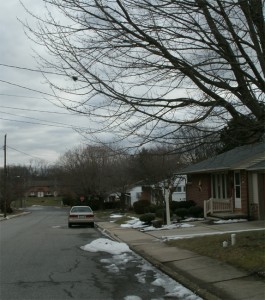By Corinne H. Smith
“Mr. Stewart tells me that he has found a gray squirrel’s nest up the Assabet, in a maple tree. I resolve that I too will find it. I do not know within less than a quarter of a mile where to look, nor whether it is in a hollow tree, or in a nest of leaves. I examine the shore first and find where he landed. I then examine the maples in that neighborhood to see what one has been climbed. I soon find one the bark of which has been lately rubbed by the boots of a climber, and, looking up, see a nest. It was a large nest made of maple twigs, with a centre of leaves, lined with fiber, about twenty feet from the ground, against the leading stem of a large red maple. … There was quite a depth of loose sticks, maple twigs, piled on the top of the nest. No wonder that they become skillful climbers who are born high above the ground and begin their lives in a tree, having first of all to descend to reach the earth. They are cradled in a tree-top, in but a loose basket, in helpless infancy, and there slumber when their mother is away. No wonder that they are never made dizzy by high climbing, that were born in the top of a tree, and learn to cling fast to the tree before their eyes are open.” ~ Thoreau’s journal, April 22, 1860
Gosh, Henry. I guess early spring would be a decent time to search for nests, especially if you hope to find brand-new offspring. But I prefer mid-winter, when the nests are empty. In fact, I think this is one of the joys of the season. Right before our eyes, Nature has unveiled evidence of random spring and summer residences. Months ago everything was hidden by leaves and shrubbery. Now the curtain has been lifted and we can see back stage. The sight reminds me of a better known Thoreau quote: “The Universe is wider than our views of it.”
These days, I delight in walking and driving around the countryside. I scrutinize each lacy silhouette against the white winter sky, looking for a clump or knot. The first one I noticed was the robin’s nest in our front yard. It lay next to the utility lines, a few branches away from the place where they had built one the previous year. They may have even taken some of the material from the old nest to make the new. But how did it ever stay in place, wedged between only a few young cross shoots? Their engineering skills amaze me.
This cup of interwoven twigs and grasses was vital when it once held a parent bird, eggs, and then nestlings. But it was only necessary for raising the kids. When everyone could fly, they left. Now that architectural marvels like this are open to the wind and to all kinds of precipitation, they’re beginning to fall apart. Eventually they’ll just disappear into the fabric of our local habitat. This is Life. This is Nature.
I spied a tiny nest in my neighbor’s bushy roadside border. Who had lived in it? I wondered. Many of us had walked within inches of it on our way to the grocery store up the block. No one saw it then. Sadly, I suspect that not many of the passers-by see it today, either.
A tall sugar maple down the street stretches itself high across our road. Now we can spot a small nest sitting on one of those overhanging limbs. Every one of us drove beneath a bird family every day without realizing it. What a wonderful sight it is now! But how did those guys ever hang on in a storm?
Then there was my major discovery while raking up leaves in the backyard. Pausing in my task to look up, I saw a large and leafy squirrel nest perched near the top of our white pine. (Unfortunately, it doesn’t photograph well, even though it is clear enough to the naked eye.) These critters sure are smart, building their condo right next to an oak tree that can supply them with an almost endless supply of acorns. Now I know why I’ve seen so many fuzzy gray bodies bounding across our back yard lately. We are co-boarders of this property.
Seeing these nests has led me to consider minimalism. These animals need only a few basic resources to survive. Compare their homes to our own, filled with clutter and crap. Do we really need so much stuff? Probably not.
I suppose we could learn a lot from the birds and the squirrels, and from the other feather- and fur-bearers we share this planet with. All is takes is the sight of an old nest in a tree to get me thinking.


